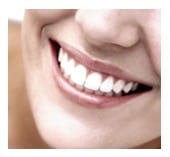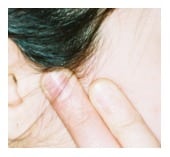Please select the procedure you received to see a summary of post-op instructions. Call us if you have any questions:
Extraction:
1- Pressure should be placed on the gauze pad that has been put over the extraction site for one hour. If the bleeding continues new gauze should be placed and pressure applied for another 45 minutes.
2- If you are supervising children who have had an extraction done, make sure they dont bite on their numb lips or tongue (it can cause serious injury to their soft tissue).
3- Avoid eating or drinking anything hot on the day of your extraction. Also, do not rinse your mouth and do not use a straw for drinking. Do not spit and do not drink carbonated beverages. Do not brush on the day of the surgery; you can gently resume your brushing and flossing the day after.
4-You may experience some pain, bruising around your lips, and/or some swelling, especially after extraction of impacted wisdom teeth. Ice bag application and medication prescribed for you will help to minimize your discomfort.
5- Please take all the medication you have received based on the provided instructions.
6- During the first 2-3 days after surgery a diet of soft food and liquids is recommended (soup, yogurt, milkshakes and juice).
7- For more complex surgical procedures, including Impacted Wisdom Tooth Extraction, Implant Surgical Procedures, etc: You will receive an ice wrap which should be worn for the rest of the day until you go to bed on the day of surgery (10 minutes on and 5 minutes off). Instructions for various surgical treatments will have some unique directions, which will be supplied to you at the time of your treatment.
8- Call our office if you experience excessive bleeding, severe pain or swelling, or if you have any questions or concerns. In case of serious emergencies call 911.
Fillings:
1- Do not eat on your new filling for one hour and until your numbness is gone.
2- If you are supervising children who had fillings done, make sure they dont bite on their numb lips or tongue (it can cause serious injury to their soft tissue).
3- Do not bite hard or chew on silver amalgam fillings for 24 hours.
4- You may experience cold and heat sensitivity and some gum soreness; this usually subsides within a few days.
5- Call our office if you experience pain or discomfort for more than a few days after the fillings, or if you have any questions.
Crowns and Bridges (also Inlays and Onlays):
1- Crowns and bridges usually take 2 or 3 appointments to complete. On the first appointment, the tooth/teeth are prepared, impressions are taken, and a temporary crown is placed on your tooth/teeth.
2- You may experience sensitivity, gum soreness, and slight discomfort on the tooth/teeth; it should subside after the placement of the permanent crown(s).
3- Whenever anesthesia is used, avoid chewing on your teeth until the numbness has worn off.
4- A temporary crown is usually made of plastic-based material or soft metal. It can break if too much pressure is placed on it. The crown may also come off; if it does, save the crown and call our office. The temporary crown is placed to protect the tooth and prevent other teeth from moving. If it comes off it should be replaced as soon as possible. To avoid losing your temporary, do not chew on sticky or hard food (chewing gum, ice). Try to chew on the opposite side of the temporary as much as possible.
5- Continue your normal brushing but be careful while flossing around the temporaries (remove the floss gently from the side). If it is difficult to get the floss between the temporary and surrounding teeth, refrain from flossing until you receive your permanent crown.
6- After the permanent restoration is placed you may feel slight pressure for a few days. Also, the bite may feel different for a day or two. But if after 2-3 days the bite still feels uneven or if you feel discomfort when chewing on the tooth, call our office. Delaying the necessary adjustments may damage the tooth permanently.
7- Call our office if you are in pain or if you have any questions.
Root Canal Treatment:
1- You may experience moderate pain and sensitivity to pressure on your tooth. Also, you may feel gum soreness for few days after your treatment. The healing process may take several days but the pain and discomfort should subside gradually.
2- Take any medication that was prescribed for you according to instructions.
3- Usually a temporary filling has been placed on your tooth; do not bite on the tooth for one hour and while you are numb. Also, until the permanent restoration is placed, be very gentle with the tooth. Try to chew with the opposite side.
4- Continue your brushing and flossing.
5- Follow up with the placement of your permanent restoration as you have been advised. Any unnecessary delay in placement of final restoration may damage the tooth permanently.
6- Call our office if you are in severe pain or experience swelling, or if you have any questions.
Teeth Cleaning (Deep Cleaning):
1- You may experience some cold and heat sensitivity (especially after deep cleaning).
2- If you have received anesthesia do not eat anything until the numbness has worn off.
3- Continue your regular brushing and flossing.
4- Some bleeding for a day or two after cleaning is normal, but if you experience any excessive bleeding call our office.
5- Call our office if you are in pain or if you have any questions.
Placement of Braces:
1- You may experience some pressure and discomfort on your teeth.
2- Be gentle with braces and avoid chewing hard and/or sticky food.
3- Brushing and flossing around braces is sometimes challenging and time consuming, but very important.
4- Call our office if you have any questions.
Gum Surgery:
1- You may experience some pain, swelling, and bleeding after the surgery.
2- Take all medication that was prescribed for you according to instructions.
3- Apply an ice bag on your face over the surgical site on the day of surgery for 10 minutes on and 5 minutes off.
4- Keep your next appointment on time for removal of sutures and follow up checks.
5- DO NOT raise your lips with your fingers to inspect the treated area.
6- DO NOT brush teeth near the surgical site. Brush teeth in the rest of your mouth.
7- There is often a temporary loss of feeling in the operated area and the tooth may feel loose.
8- Do not smoke, spit, or use a straw on the day of the surgery (avoid smoking for a few days after the surgery).
9- Should any difficulties occur, do not hesitate to call our office anytime. In case of serious emergencies call 911.
Implant Surgery:
1- You may experience some discomfort and bleeding the day of the surgery.
2- Take all medication that was prescribed for you according to instructions.
3- Apply an ice bag on your face over the surgical site on the day of surgery for 10 minutes on and 5 minutes off.
4- Keep your next appointment on time for removal of sutures and follow up checks.
5- DO NOT raise your lips with your fingers to inspect the treated area.
6- DO NOT brush teeth near the surgical site. Brush teeth in the rest of your mouth.
7- There is often a temporary loss of feeling in the operated area and the tooth may feel loose.
8- Do not smoke, spit, or use a straw on the day of the surgery (avoid smoking for a few days after the surgery).
9- Should any difficulties occur, do not hesitate to call our office anytime. In case of serious emergencies call 911.
Denture Delivery:
1- You will experience some discomfort with any new denture for a few days. All new dentures need several adjustments to completely and comfortably fit your mouth.
2- You should take the dentures out every night and keep them in a clean container filled with water or denture cleaning solution. Your gums need to rest and be without the dentures every day for a period of time.
3- Clean dentures thoroughly with a brush and water before putting them back in your mouth.
4- It may be difficult to talk normally with the new dentures for a few days. One way to practice is to read a book or newspaper out loud for a period of time everyday. Your tongue and muscles will get used to the new dentures and you will talk normally very soon.
5- Call our office if you are experiencing pain, discomfort, or if you have any questions.
Apicoectomy (Root Canal Surgery):
1- Swelling, minor pain and/or skin discoloration may be experienced following the surgical procedure. This will be temporary.
2- In order to keep the swelling to a minimum, use an ice pack for the first few hours after surgery (on for 10 minutes and off for 5 minutes).
3- The day after the surgery, use lukewarm water rinses for the treated area following each meal. This should continue for the first 3 days following the surgical procedure.
4- Eat only soft foods. Avoid hard and chewy foods.
5- Get plenty of rest and insure normal intake of food, especially liquids such as fruit juices, soup, and milk. Use a vitamin supplement if desired. Try not to sleep on the operated area for 2-3 days.
6- DO NOT raise your lips with your fingers to inspect the treated area.
7- DO NOT brush teeth near the surgical site. Brush teeth in the rest of your mouth.
8- There is often a temporary loss of feeling in the operated area and the tooth may feel loose.
9- Take all medication that was prescribed for you according to instructions.
10- Should any difficulties occur, do not hesitate to call our office anytime. In case of serious emergencies call 911.
Bone Graft Surgery
You have just had surgery completed for the reduction of periodontal pocketing and/or for replacement of bone in an area where pathology existed, or in conjunction with endosseous dental implant surgical placement with or without platelet addition to the bone graft. You will be advised of the particular procedure and pertinent directions relative to your treatment modality. Whether you were put to sleep for this procedure or were only given local anesthesia, the post-operative instructions remain the same.
You will have several sutures (stitches) placed at the surgical site. These sutures may or may not be resorbable. If you have been told that you received external silk sutures, they have to be removed by us. The sutures will cause a pulling of your tissue over the bone grafting site. Since the bone graft site will have approximately 15 % more bone fill than what was naturally there, it is imperative that you do not pull up your lips or cheeks to show or examine the area. The undue pressure will cause the sutures to widen away from the surgical site, expose bone, create more pain, and delay healing dramatically. This delay can lead to the need for the area to be sutured again when you are seen for your 1 week post-surgical evaluation. The sutures will remain in place for 2 to 3 weeks depending on the size of the graft, the severity of the pathology, and the condition of the tissue being sutured.
Your doctor will tell you what time period to expect, but keep in mind that this is not etched in stone and the doctor may extend the time before your sutures are removed to assure adequate healing and to avoid surgical regression.
You also may have a periodontal pack placed over the surgical site. The pack is pink in color and impregnated with antibiotic, which will protect the surgical site from infection and any washout of the particulate bone utilized to restore your jaw. The pack should be left in place for as long as possible. If a pack is placed the doctor will remove the packing at your 1 week follow up and decide if the packing should be replaced or kept off. Usually the packing is kept on for 7 to 10 days at a minimum. You must return to the office if your pack falls off before you are seen for your 1 week follow up.
Your maintenance during healing has to be completed carefully. You can brush in every area except where the periodontal pack is placed. It is imperative that you use NO ASTRINGENTS such as mouth wash or antiseptic solutions during the healing period of your bone graft. Listerine, Viadent, or any other potentially caustic agent can RUIN your bone grafting procedure if contaminated, and require a replacement bone graft. The doctor and our staff will reiterate this to you at, during, and after your bone graft surgical procedure. After the first stages of healing are satisfactory, we will provide you with normal saline and instruct you on how to use it (with or without the addition of salt), as well as irrigation syringes for cleaning the surgical site.
Since bone grows and heals slowly, it requires conditions conducive to a proper environment and blood supply. Thus, it is imperative that immediately after your bone graft you alter your diet, as you would for any oral surgical procedure. This means that you should not eat anything that is too large, too hot, or too sticky. Your food should be tepid or on the cool side. Any food that is too hot will have a deleterious effect on your surgical procedure. Commonsense must be used in determining what should be done or avoided. If for some reason you have questions about anything post-surgically, please call the office and we will inform you of the proper action to take.
Smoking after any oral surgical procedure will ALWAYS delay or disrupt normal healing due to a decrease in oxygenation of the tissue that is healing. Smoking should therefore be stopped for the first 7 to 10 days to allow for adequate initial tissue closure. Complete epithilization (closure) and wound healing normally takes a minimum of 21 days from the day the surgery was completed under ideal healing conditions, and with no other underlying systemic causes such as Diabetes Melitus, etc.
Bone grafting is a very predictable surgical procedure when done correctly and when patient cooperation is adhered to. Please try to be reasonable in understanding that this procedure has inherent risks associated with it, as stated in your informed consents. Some of these risks are also pertinent to your post-operative care.
We want nothing more than a perfect outcome with the surgical procedures that you are having done to rehabilitate your bone. This can only be attained with your cooperation. Please feel free to communicate with us at any time to make sure that the procedures you are having are properly maintained. No question is ever perceived by our office as being silly or unreasonable. We would rather have questions answered immediately than risk the chance that the procedure will not go as planned, especially from omissions that are preventable.
As stated above and outlined in your informed consents, please remember that there are some instances when no matter what is done, the outcome is not perfect. There are even infrequent occasions when a surgery may have to be redone; these situations are neither the doctors nor the patients fault.
Thank you











